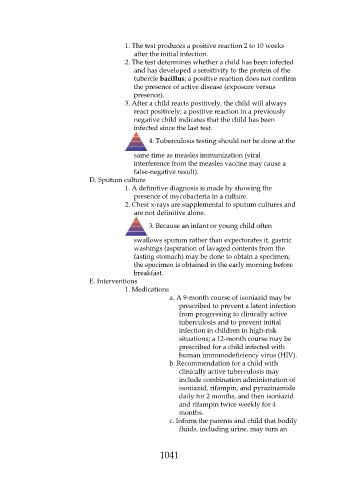Page 1041 - Saunders Comprehensive Review For NCLEX-RN
P. 1041
1. The test produces a positive reaction 2 to 10 weeks
after the initial infection.
2. The test determines whether a child has been infected
and has developed a sensitivity to the protein of the
tubercle bacillus; a positive reaction does not confirm
the presence of active disease (exposure versus
presence).
3. After a child reacts positively, the child will always
react positively; a positive reaction in a previously
negative child indicates that the child has been
infected since the last test.
4. Tuberculosis testing should not be done at the
same time as measles immunization (viral
interference from the measles vaccine may cause a
false-negative result).
D. Sputum culture
1. A definitive diagnosis is made by showing the
presence of mycobacteria in a culture.
2. Chest x-rays are supplemental to sputum cultures and
are not definitive alone.
3. Because an infant or young child often
swallows sputum rather than expectorates it, gastric
washings (aspiration of lavaged contents from the
fasting stomach) may be done to obtain a specimen;
the specimen is obtained in the early morning before
breakfast.
E. Interventions
1. Medications
a. A 9-month course of isoniazid may be
prescribed to prevent a latent infection
from progressing to clinically active
tuberculosis and to prevent initial
infection in children in high-risk
situations; a 12-month course may be
prescribed for a child infected with
human immunodeficiency virus (HIV).
b. Recommendation for a child with
clinically active tuberculosis may
include combination administration of
isoniazid, rifampin, and pyrazinamide
daily for 2 months, and then isoniazid
and rifampin twice weekly for 4
months.
c. Inform the parents and child that bodily
fluids, including urine, may turn an
1041

